2023 FORD BRONCO SPORT inflation pressure
[x] Cancel search: inflation pressurePage 325 of 516
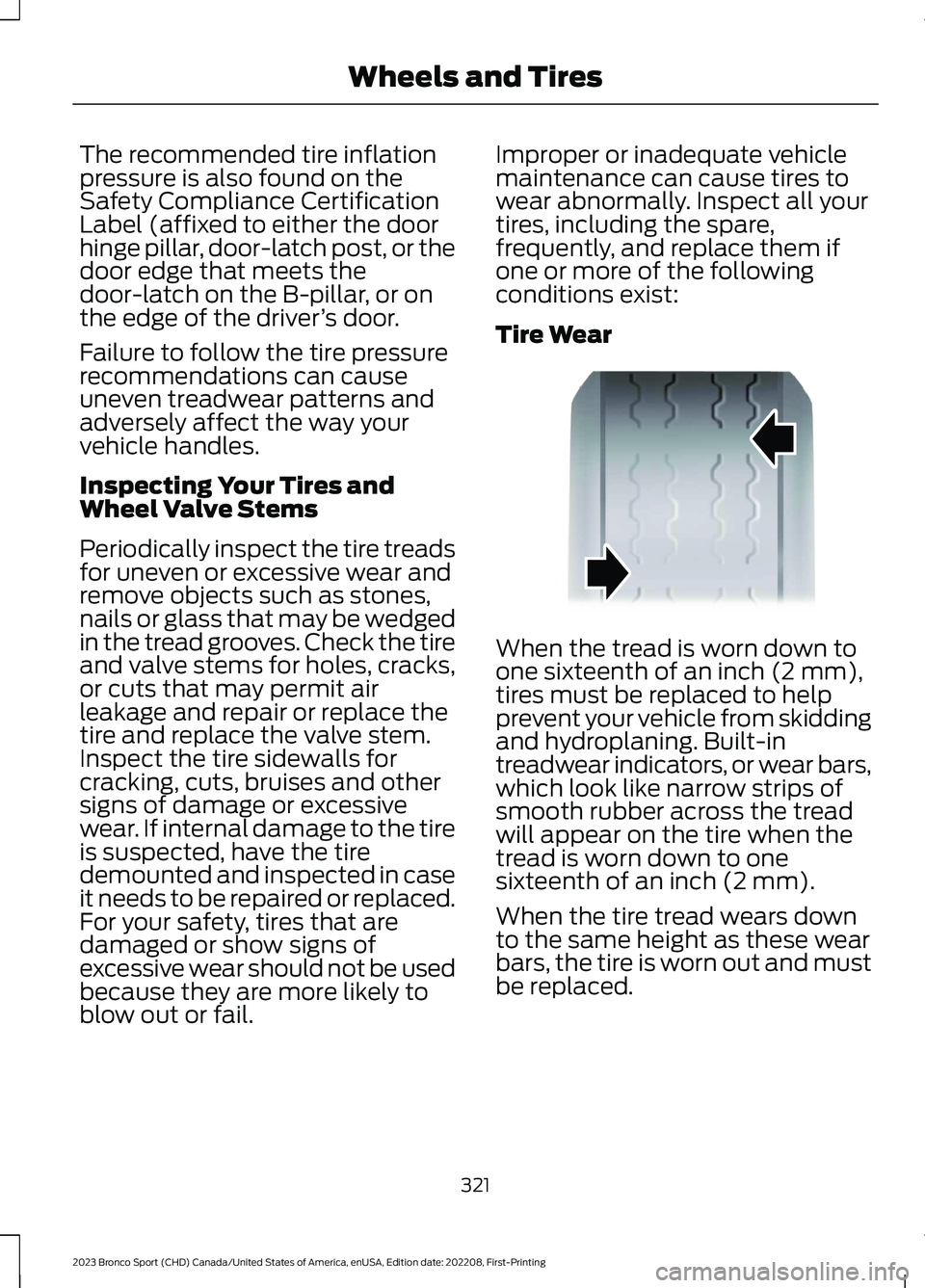
The recommended tire inflationpressure is also found on theSafety Compliance CertificationLabel (affixed to either the doorhinge pillar, door-latch post, or thedoor edge that meets thedoor-latch on the B-pillar, or onthe edge of the driver’s door.
Failure to follow the tire pressurerecommendations can causeuneven treadwear patterns andadversely affect the way yourvehicle handles.
Inspecting Your Tires andWheel Valve Stems
Periodically inspect the tire treadsfor uneven or excessive wear andremove objects such as stones,nails or glass that may be wedged
in the tread grooves. Check the tireand valve stems for holes, cracks,or cuts that may permit airleakage and repair or replace thetire and replace the valve stem.Inspect the tire sidewalls forcracking, cuts, bruises and othersigns of damage or excessivewear. If internal damage to the tireis suspected, have the tiredemounted and inspected in caseit needs to be repaired or replaced.For your safety, tires that aredamaged or show signs ofexcessive wear should not be usedbecause they are more likely toblow out or fail.
Improper or inadequate vehiclemaintenance can cause tires towear abnormally. Inspect all yourtires, including the spare,frequently, and replace them ifone or more of the followingconditions exist:
Tire Wear
When the tread is worn down toone sixteenth of an inch (2 mm),tires must be replaced to helpprevent your vehicle from skiddingand hydroplaning. Built-intreadwear indicators, or wear bars,which look like narrow strips ofsmooth rubber across the treadwill appear on the tire when thetread is worn down to onesixteenth of an inch (2 mm).
When the tire tread wears downto the same height as these wearbars, the tire is worn out and mustbe replaced.
321
2023 Bronco Sport (CHD) Canada/United States of America, enUSA, Edition date: 202208, First-PrintingWheels and TiresE142546
Page 326 of 516
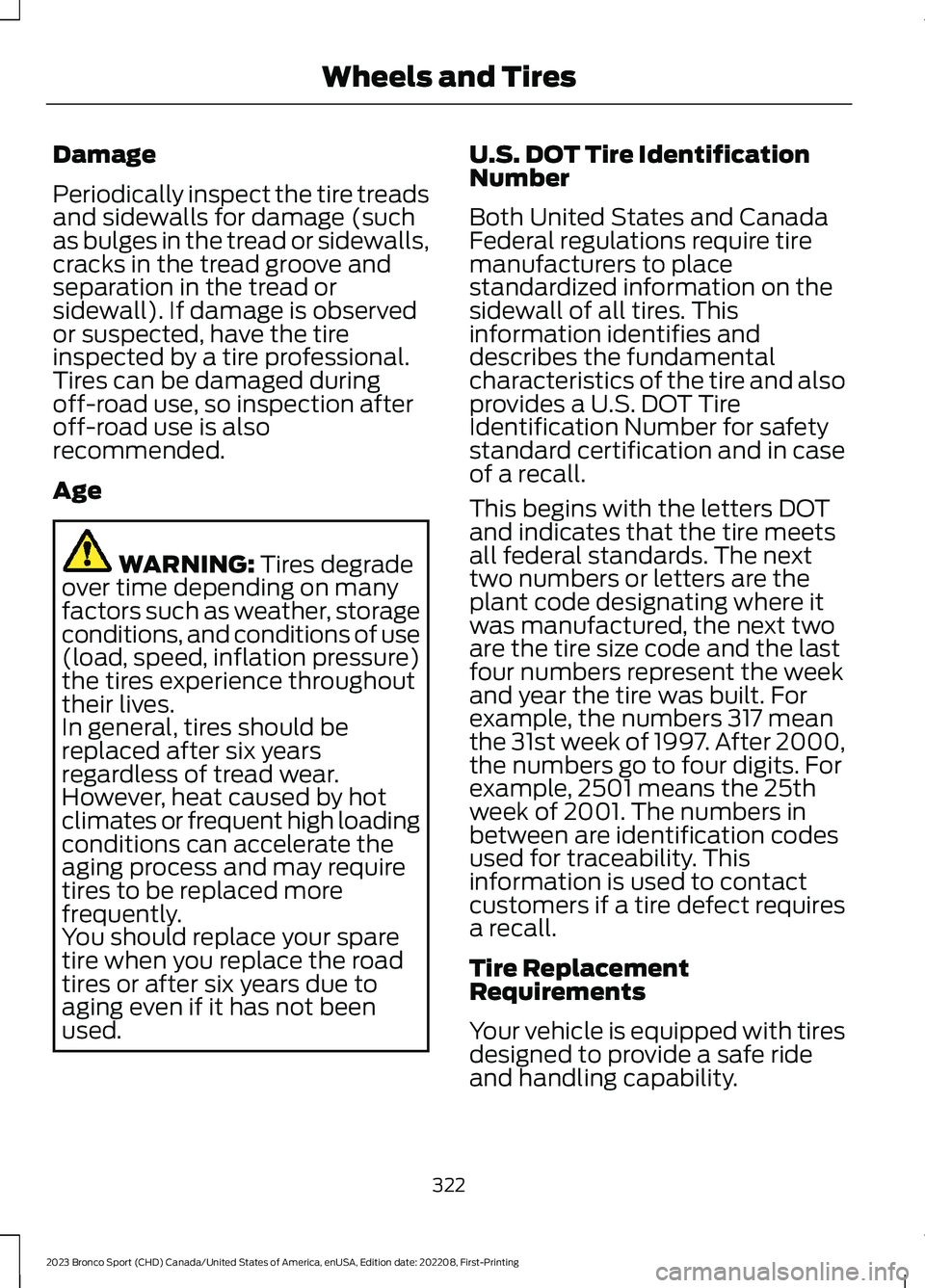
Damage
Periodically inspect the tire treadsand sidewalls for damage (suchas bulges in the tread or sidewalls,cracks in the tread groove andseparation in the tread orsidewall). If damage is observedor suspected, have the tireinspected by a tire professional.Tires can be damaged duringoff-road use, so inspection afteroff-road use is alsorecommended.
Age
WARNING: Tires degradeover time depending on manyfactors such as weather, storageconditions, and conditions of use(load, speed, inflation pressure)the tires experience throughouttheir lives.In general, tires should bereplaced after six yearsregardless of tread wear.However, heat caused by hotclimates or frequent high loadingconditions can accelerate theaging process and may requiretires to be replaced morefrequently.
You should replace your sparetire when you replace the roadtires or after six years due toaging even if it has not beenused.
U.S. DOT Tire IdentificationNumber
Both United States and CanadaFederal regulations require tiremanufacturers to placestandardized information on thesidewall of all tires. Thisinformation identifies anddescribes the fundamentalcharacteristics of the tire and alsoprovides a U.S. DOT TireIdentification Number for safetystandard certification and in caseof a recall.
This begins with the letters DOTand indicates that the tire meetsall federal standards. The nexttwo numbers or letters are theplant code designating where itwas manufactured, the next twoare the tire size code and the lastfour numbers represent the weekand year the tire was built. Forexample, the numbers 317 meanthe 31st week of 1997. After 2000,the numbers go to four digits. Forexample, 2501 means the 25thweek of 2001. The numbers inbetween are identification codesused for traceability. Thisinformation is used to contactcustomers if a tire defect requiresa recall.
Tire ReplacementRequirements
Your vehicle is equipped with tiresdesigned to provide a safe rideand handling capability.
322
2023 Bronco Sport (CHD) Canada/United States of America, enUSA, Edition date: 202208, First-PrintingWheels and Tires
Page 329 of 516
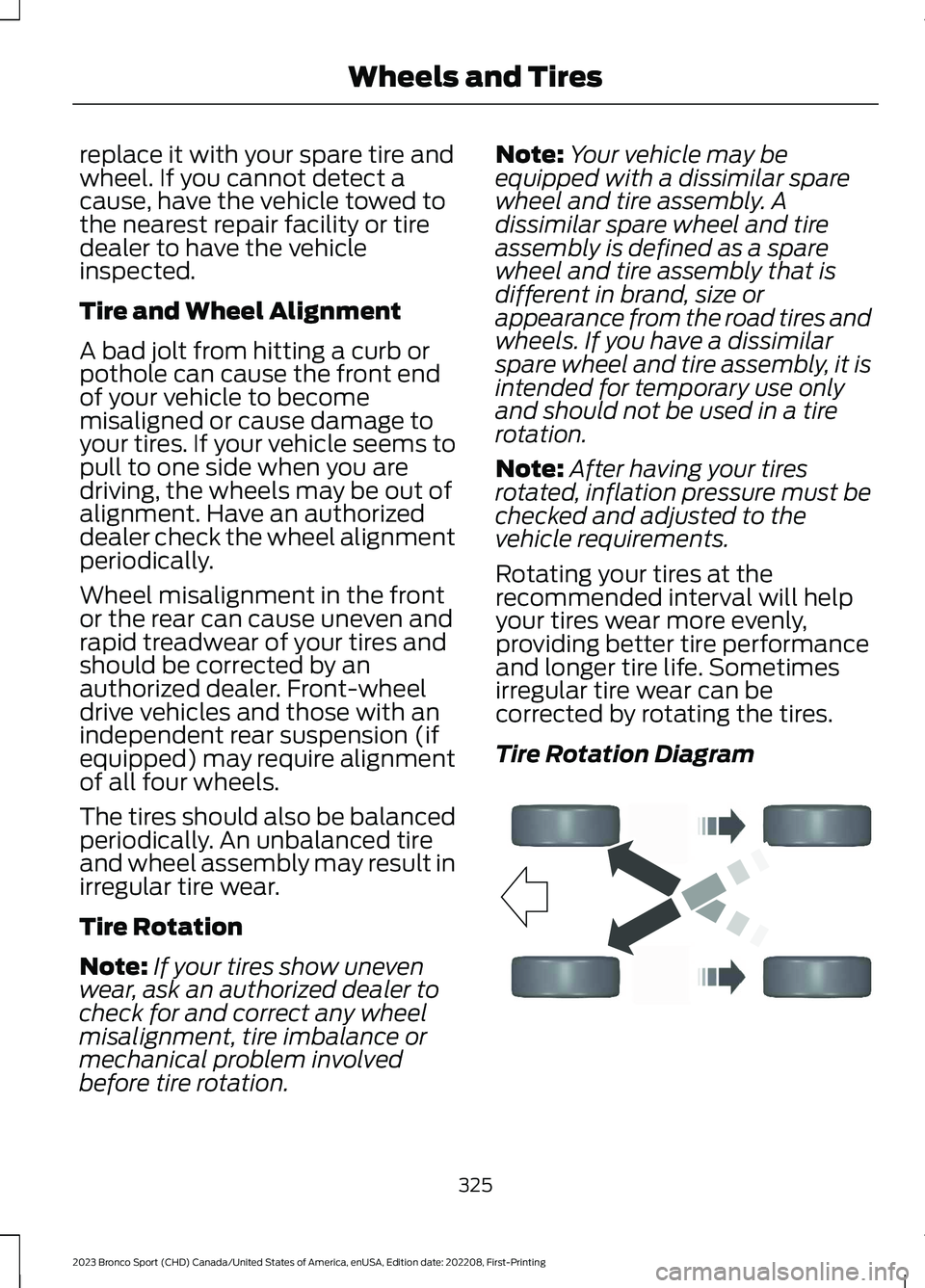
replace it with your spare tire andwheel. If you cannot detect acause, have the vehicle towed tothe nearest repair facility or tiredealer to have the vehicleinspected.
Tire and Wheel Alignment
A bad jolt from hitting a curb orpothole can cause the front endof your vehicle to becomemisaligned or cause damage toyour tires. If your vehicle seems topull to one side when you aredriving, the wheels may be out ofalignment. Have an authorizeddealer check the wheel alignmentperiodically.
Wheel misalignment in the frontor the rear can cause uneven and
rapid treadwear of your tires andshould be corrected by anauthorized dealer. Front-wheeldrive vehicles and those with anindependent rear suspension (ifequipped) may require alignmentof all four wheels.
The tires should also be balancedperiodically. An unbalanced tireand wheel assembly may result inirregular tire wear.
Tire Rotation
Note:If your tires show unevenwear, ask an authorized dealer tocheck for and correct any wheelmisalignment, tire imbalance ormechanical problem involvedbefore tire rotation.
Note:Your vehicle may beequipped with a dissimilar sparewheel and tire assembly. Adissimilar spare wheel and tireassembly is defined as a sparewheel and tire assembly that isdifferent in brand, size orappearance from the road tires andwheels. If you have a dissimilarspare wheel and tire assembly, it isintended for temporary use onlyand should not be used in a tirerotation.
Note:After having your tiresrotated, inflation pressure must bechecked and adjusted to thevehicle requirements.
Rotating your tires at therecommended interval will helpyour tires wear more evenly,providing better tire performanceand longer tire life. Sometimesirregular tire wear can becorrected by rotating the tires.
Tire Rotation Diagram
325
2023 Bronco Sport (CHD) Canada/United States of America, enUSA, Edition date: 202208, First-PrintingWheels and TiresE142547
Page 331 of 516
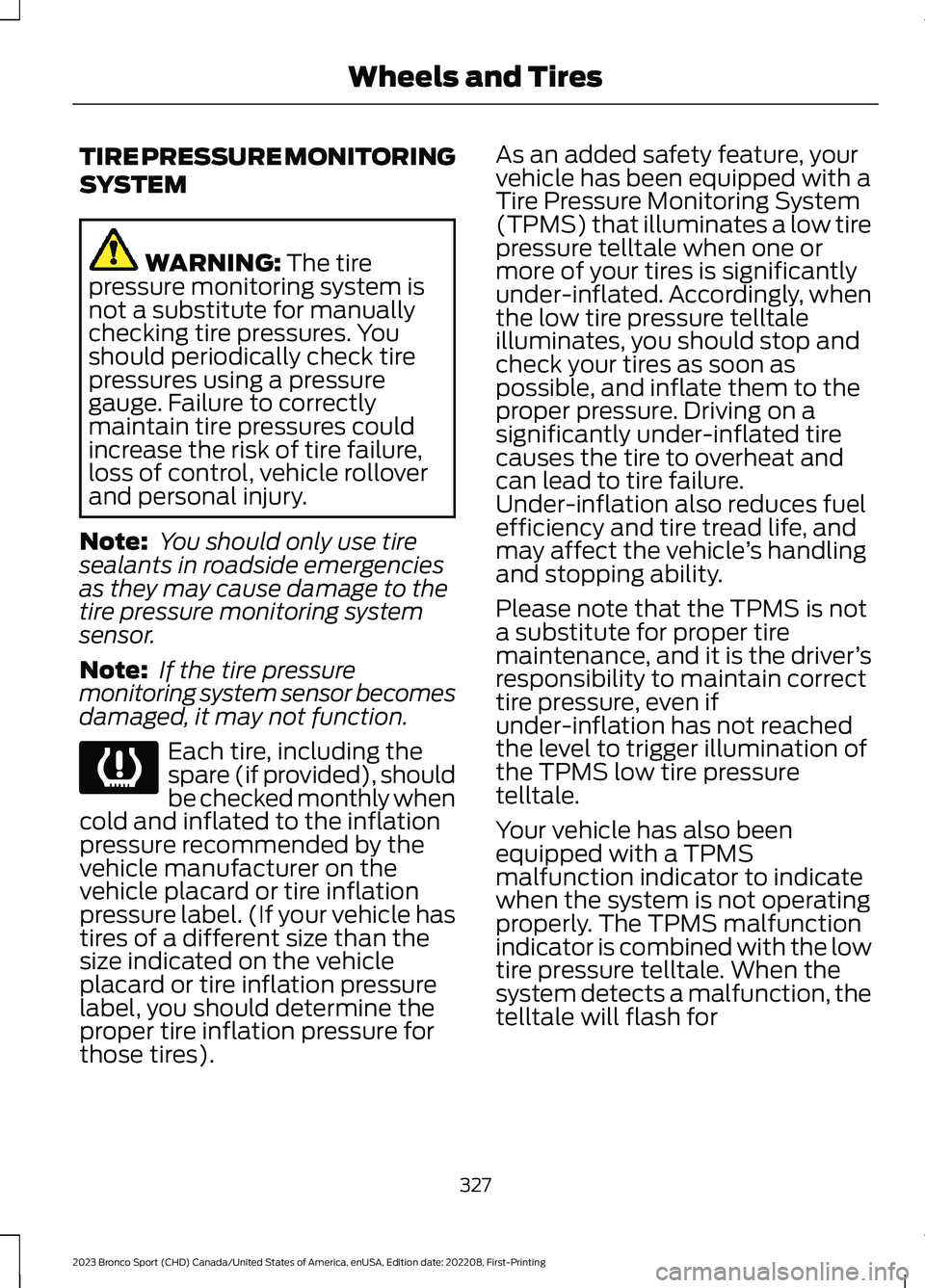
TIRE PRESSURE MONITORING
SYSTEM
WARNING: The tirepressure monitoring system isnot a substitute for manuallychecking tire pressures. Youshould periodically check tirepressures using a pressuregauge. Failure to correctlymaintain tire pressures couldincrease the risk of tire failure,loss of control, vehicle rolloverand personal injury.
Note: You should only use tiresealants in roadside emergenciesas they may cause damage to thetire pressure monitoring systemsensor.
Note: If the tire pressuremonitoring system sensor becomesdamaged, it may not function.
Each tire, including thespare (if provided), shouldbe checked monthly whencold and inflated to the inflationpressure recommended by thevehicle manufacturer on thevehicle placard or tire inflationpressure label. (If your vehicle hastires of a different size than thesize indicated on the vehicleplacard or tire inflation pressurelabel, you should determine theproper tire inflation pressure forthose tires).
As an added safety feature, yourvehicle has been equipped with aTire Pressure Monitoring System(TPMS) that illuminates a low tirepressure telltale when one ormore of your tires is significantlyunder-inflated. Accordingly, whenthe low tire pressure telltaleilluminates, you should stop andcheck your tires as soon aspossible, and inflate them to theproper pressure. Driving on asignificantly under-inflated tirecauses the tire to overheat andcan lead to tire failure.Under-inflation also reduces fuelefficiency and tire tread life, andmay affect the vehicle’s handlingand stopping ability.
Please note that the TPMS is nota substitute for proper tiremaintenance, and it is the driver’sresponsibility to maintain correcttire pressure, even ifunder-inflation has not reachedthe level to trigger illumination ofthe TPMS low tire pressuretelltale.
Your vehicle has also beenequipped with a TPMSmalfunction indicator to indicatewhen the system is not operatingproperly. The TPMS malfunctionindicator is combined with the lowtire pressure telltale. When thesystem detects a malfunction, thetelltale will flash for
327
2023 Bronco Sport (CHD) Canada/United States of America, enUSA, Edition date: 202208, First-PrintingWheels and TiresE139232
Page 335 of 516
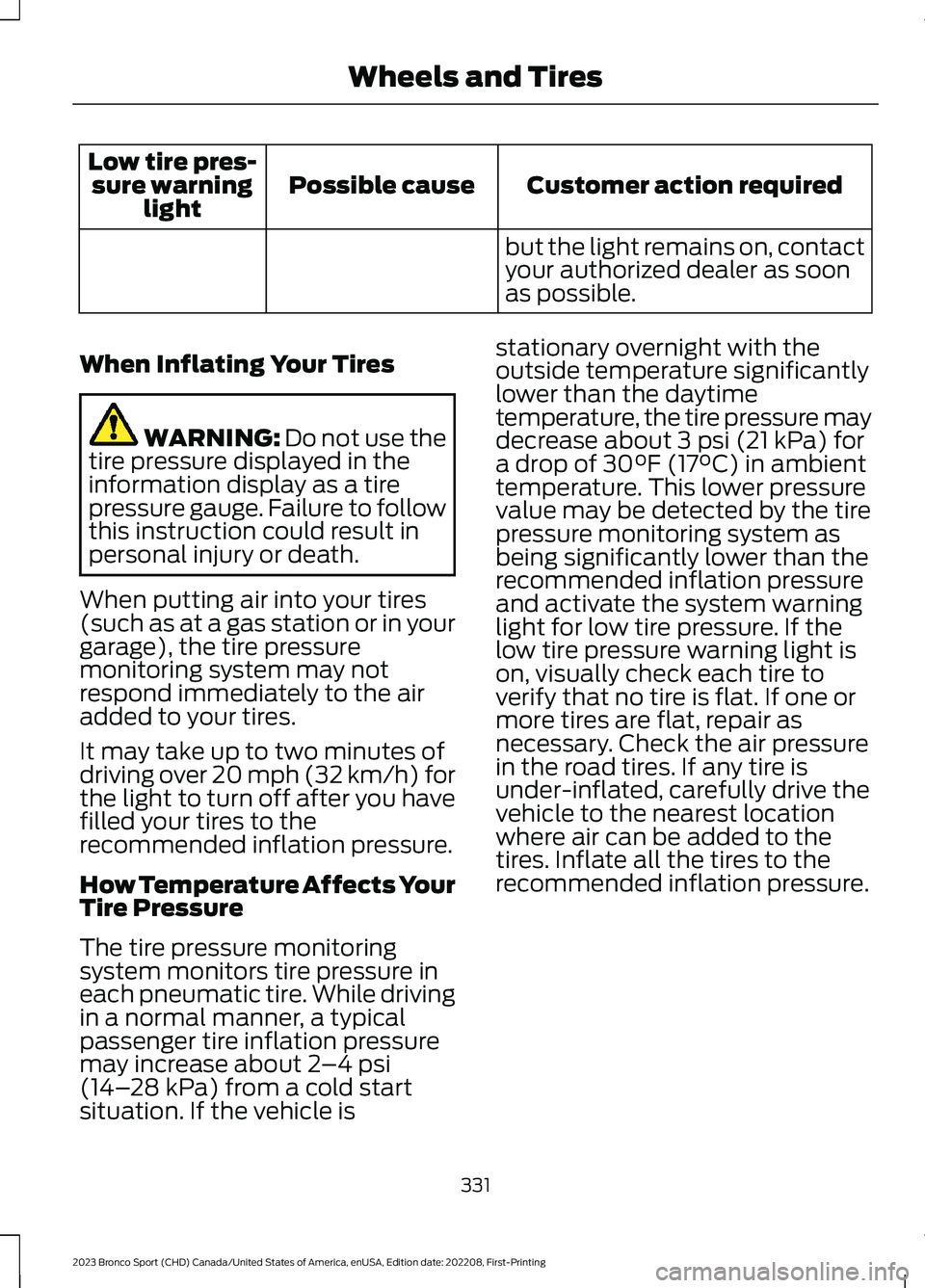
Customer action requiredPossible causeLow tire pres-sure warninglight
but the light remains on, contactyour authorized dealer as soonas possible.
When Inflating Your Tires
WARNING: Do not use thetire pressure displayed in theinformation display as a tirepressure gauge. Failure to followthis instruction could result inpersonal injury or death.
When putting air into your tires(such as at a gas station or in yourgarage), the tire pressuremonitoring system may notrespond immediately to the airadded to your tires.
It may take up to two minutes ofdriving over 20 mph (32 km/h) forthe light to turn off after you havefilled your tires to therecommended inflation pressure.
How Temperature Affects YourTire Pressure
The tire pressure monitoringsystem monitors tire pressure ineach pneumatic tire. While drivingin a normal manner, a typicalpassenger tire inflation pressuremay increase about 2–4 psi(14–28 kPa) from a cold startsituation. If the vehicle is
stationary overnight with theoutside temperature significantlylower than the daytimetemperature, the tire pressure maydecrease about 3 psi (21 kPa) fora drop of 30°F (17°C) in ambienttemperature. This lower pressurevalue may be detected by the tirepressure monitoring system asbeing significantly lower than therecommended inflation pressureand activate the system warninglight for low tire pressure. If thelow tire pressure warning light ison, visually check each tire toverify that no tire is flat. If one ormore tires are flat, repair asnecessary. Check the air pressurein the road tires. If any tire isunder-inflated, carefully drive thevehicle to the nearest locationwhere air can be added to thetires. Inflate all the tires to therecommended inflation pressure.
331
2023 Bronco Sport (CHD) Canada/United States of America, enUSA, Edition date: 202208, First-PrintingWheels and Tires